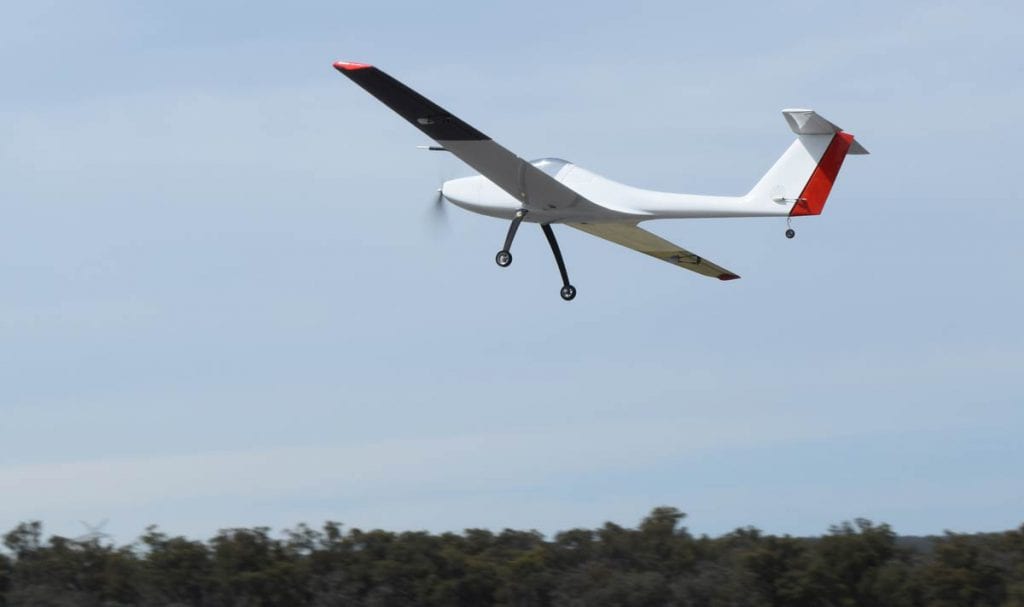Australian Researchers Fly Hydrogen-Powered Drone
The triple hybrid propulsion system is the brain child of University of Sydney aerospace engineering PhD candidate Andrew Gong, supported by a highly qualified team of researchers – including Dr Dries Verstraete from the University’s School of Aerospace, Mechanical and Mechatronic Engineering (AMME), and Dr Jennifer Palmer from Defence Science and Technology Group.
Building upon four test flights using hydrogen fuel cells the team performed late last year, the new results demonstrate improved dynamic response of the overall triple hybrid propulsion system and smoothing of energy load, meaning increased fuel-cell life.
While the project’s primary goal is to improve the flexibility and robustness of hydrogen fuel cell-based hybrid power systems in remotely piloted aircraft, Gong told Drone Below, “Although we haven’t explored it, there is definitely scope to use hydrogen fuel cell propulsion in underwater ROVs or AUVs.”
Gong also sees the potential for further advancement of larger drone tech, such as air taxis, adding, “The same benefits of enhanced endurance and range using hydrogen fuel cell propulsion applies to larger vehicles. Unless there is a radical breakthrough in battery technology, electric aircraft using batteries will be extremely limited in range and endurance. A hydrogen fuel cell allows much longer flight time in electric aircraft.”
The technology would also mean better endurance for industrial applications such as agriculture and mining – and improved carbon emissions.
“Hydrogen power provides much greater range and endurance compared to existing small electric unmanned aircraft. In the future, this may be useful for extended-duration inspection or surveillance tasks, such as surveying large agricultural properties or inspecting pipelines and other infrastructure,” Mr Gong said.
“Hydrogen fuel cells are also more environmentally friendly because they produce zero CO2 emissions and are much quieter than other fossil-fuelled aircraft.”
Aircraft manufacturers are slow to take up hydrogen fuel cell technology because current systems are costly, have power limitations and poor response to changes in load.
Using the hybrid combination of fuel cells with batteries and supercapacitators, the team have been able to overcome these challenges, improving peak power and load response. For aircraft and drone manufacturers, this will mean much improved performance for launches and high-load routines such as tight manoeuvres.

The hydrogen-powered drone in flight | University of Sydney
“Conceptually, this is similar to a hybrid car where the battery is an auxiliary power source,” Mr Gong said. “Our hybrid system improves the performance capabilities of existing fuel cell systems, and provides new options for quiet, long-endurance propulsion in the rapidly growing unmanned aircraft industry.
Gong is aware of the challenges of flight times for autonomous public air transport systems, adding, “This is a challenging problem which I’m watching with a keen interest. If we can create a quiet, safe, reliable and autonomous air taxi, transportation will experience a paradigm shift to rival the invention of the automobile.”
He also sees a great deal of potential in other projects worldwide. Talking to Drone Below, he said that companies that excite and inspire him “push the boundaries of what is possible and turn amazing ideas into reality. Some incredible inspirations in aerospace include SpaceX with re-useable rockets that fly back and land upright, Northrop Grumman with the X-47B and its autonomous operations on an aircraft carrier, and recently the Ehang 184 with manned tests of its electric passenger drone. ”
Mr Gong’s PhD research has gained the support of Northrop Grumman Australia and the University of Sydney’s School of AMME through an Aerospace Engineering Industry Link (top-up) scholarship.
What does the future hold? Gong has some ideas: “I think the convergence of electric propulsion, autonomous technology and aircraft will enable fascinating concepts in the future. Exciting times ahead!”



















